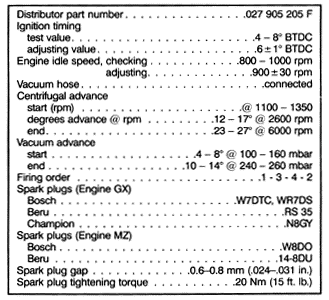4.2 Mechanical Timing Advance (basic TCI-h only, engine codes GX and MZ)Table d. Basic TCI-h Ignition System Specifications (engine codes GX and MZ)
The centrifugal weights in the distributor advance ignition timing as rpm increases. To check centrifugal advance, disconnect the vacuum advance hose at the distributor and plug the hose. Then observe the change in ignition timing at speeds above idle. Precise measurement requires an adjustable timing light which can accurately indicate how much timing changes from the basic timing value. See Table d above for centrifugal advance specifications. If the distributor's centrifugal advance mechanism is not performing properly, the distributor housing assembly should be replaced. The vacuum advance mechanism changes ignition timing according to intake manifold vacuum, an indication of the load on the engine. To check vacuum advance, remove the vacuum hose from the vacuum diaphragm on the side of the distributor and connect a substitute hose to the diaphragm. Then observe the change in ignition timing while applying vacuum to the hose. It is important that the vacuum advance diaphragm not leak. Check the diaphragm with a vacuum pump and gauge if necessary. It should hold vacuum of approximately 500 mbar, losing no more than 50 mbar in one minute. The vacuum diaphragm is available as a separate replacement part. To further check both mechanisms, remove the distributor cap. When the plate on which the Hall sender is mounted is moved counterclockwise, it should move smoothly without sticking and spring back to its original position when released. If it doesn't then the plate is binding or the vacuum advance diaphragm is faulty. The mechanism for the centrifugal advance can be checked by twisting the distributor rotor clockwise. The movement of the rotor should be smooth and it should spring back to its original position when released. |
